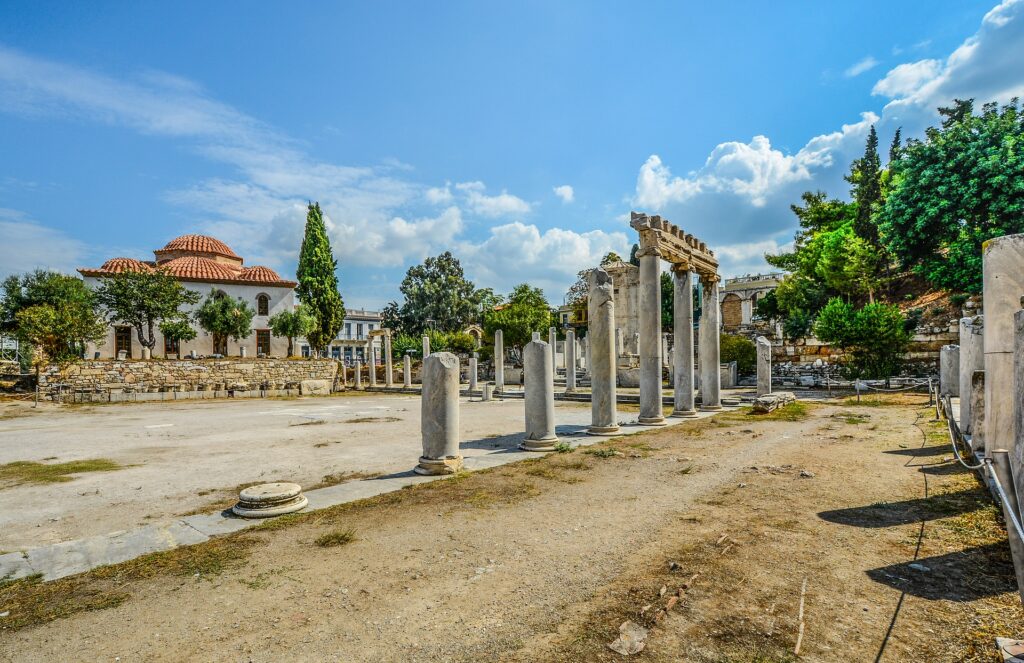For nearly as long as humanity has existed , people have been involved in various commercial activities that include bartering, selling, and consuming resources. Lets understand how ancient retail evolved from early Roman and Greek civilisations to modern day retail stores, supermarkets and e-commerce.
How Ancient Greeks and Romans did Retail Trade?
Reference Article: https://en.wikipedia.org/wiki/History_of_retail
In ancient Greece markets operated within the agora, an open space where, on market days, goods were displayed on mats or temporary stalls.In ancient Rome, trade took place in the forum. The Roman forum was arguably the earliest example of a permanent retail shop-front. By 800 BC in ancient Greece, people had developed markets with merchants selling their wares in the Agora in the city center.

The above ruins are of an Ancient Agora. People would come there not only to buy and sell but also to socialise, meet each other, and also engage in politics and government.
Who were the PHOENICIANS and how theyTraded?
The Phoenicians were a Semitic-speaking people of somewhat unknown origin who emerged in the Levant around 3000 BC. The Phoenicians came to prominence in the mid-12th century BC, following the decline of most influential cultures in the Late Bronze Age collapse.
They were renowned among contemporaries as skilled traders and mariners, becoming the dominant commercial power for much of classical antiquity.
The Phoenicians developed an expansive maritime trade network that lasted over a millennium, helping facilitate the exchange of cultures, ideas, and knowledge between major cradles of civilization such as Greece, Egypt, and Mesopotamia.
The Phoenicians were noted for their seafaring skills
They plied their ships across the Mediterranean, becoming a major trading power by the 9th century BCE. The Phoenicians imported and exported wood, textiles, glass and produce such as wine, oil, dried fruit, and nuts. Their trading skills necessitated a network of colonies along the Mediterranean coast, stretching from modern-day Crete through to Tangiers and onto Sardinia.
The Phoenicians not only traded in tangible goods, but were also instrumental in transporting culture. The Phoenician’s extensive trade networks necessitated considerable book-keeping and correspondence.
In around 1500 BCE, the Phoenicians developed a consonantal alphabet which was much easier to learn than the complex scripts used in ancient Egypt and Mesopotamia. Phoenician traders and merchants were largely responsible for spreading their alphabet around the region
Retail Trade in Medieval Europe, Middle East and England
In Medieval England and Europe, relatively few permanent shops were to be found; instead, customers walked into the tradesman’s workshops where they discussed purchasing options directly with tradesmen.
In the more populous cities, a small number of shops were beginning to emerge. Outside the major cities, most consumable purchases were made through markets or fairs.
By the 12th century there was an upsurge in the number of market towns and the emergence of merchant circuits as traders bulked up surpluses from smaller regional, different day markets and resold them at the larger centralised market towns. Market-places appear to have emerged independently outside Europe.
The Grand Bazaar in Istanbul is often cited as the world’s oldest continuously operating market; its construction began in 1455. The Spanish conquistadors wrote glowingly of markets in the Americas. In the 15th century, the Mexica (Aztec) market of Tlatelolco was the largest in all the Americas.
English market towns
They were regulated from a relatively early period. The English monarchs awarded a charter to local Lords to create markets and fairs for a town or village. This charter would grant the lords the right to take tolls and also afford some protection from rival markets.
For example, once a chartered market was granted for specific market days, a nearby rival market could not open on the same days.
Across the boroughs of England, a network of chartered markets sprang up between the 12th and 16th centuries, giving consumers reasonable choice in the markets they preferred to patronise.
A study on the purchasing habits of the monks and other individuals in medieval England, suggests that consumers of the period were relatively discerning. Purchase decisions were based on purchase criteria such as consumers’ perceptions of the range, quality, and price of goods. This informed decisions about where to make their purchases and which markets were superior.
History of the Major Trade Routes
Important Trade Routes in History
1. Silk Road
2. Spice Route
3. Royal Road
4. Incense Route:
5. The Tea Horse Road
6. The Salt Route
Read about the Trade Routes in detail here:
https://www.mentalfloss.com/article/86338/8-trade-routes-shaped-world-history https://en.wikipedia.org/wiki/Trade_route
The video below explains the the evolution of the world’s major trade routes, from the Incense Route until today on the World Map:
The major topics of discussion in this video are as following:
- The Incense Route and its role in Trade
- The Silk Road and its Impact in the Ancient World Trade
- The Roman Empire and the Arabs
- Italian Merchants
- Sea-Route to India
- The Manila Galleons
- Triangular Trade
- The Industrial Revolution
- Canals
- Globalisation
- New Silk Road
- Current Situation
Read about New Age Retail Customer and Marketing here :
https://retailmarketingtechnology.com/category/retail/customer/
https://retailmarketingtechnology.com/category/marketing/
About the Author
The Author and Editor in Chief of ReMTech.Com is an Entrepreneur, Business, Management, Marketing & Analytics Professional with 15+ Years of experience in the areas of Retail, FMCG, CPG, Marketing, Telecom, Technology, Data Science, Travel and Tourism, Food Businesses-Restaurants, Media and Entertainment, Banking and Financial Services.
He comes with great experience and skills in providing leadership, strategy and road-maps in Setting up Business from Scratch, Scouting and Hiring Talent, Marketing- Digital and Offline, Overall Management-Building Teams Operations and Logistics, Outsourcing (Setting up Technology, Retail, Consumer Operations in India in an Outsourcing Model by becoming your Outsourcing Partner or Facilitator), Consulting, Education Management, CRM-Customer Retention, Acquisition, Marketing, Analytics, Data Science Applications and Big Data Applications
For General Queries, Consulting Advice or Setting up Technology/Marketing Team in India (from Scratch in the upcoming TECH and TALENT Capitals of India-Chandigarh, Mohali, Panchkula after Bangalore, Gurgaon), kindly reach out here:


